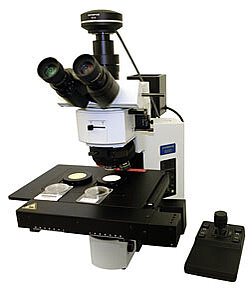
| OELCHECK test instrument: | microscope: OLYMPUS BX51 camera: OLYMPUS XC 10 software: analySIS Particle Inspector |
| Sample quantity: | 50 ml |
| Unit: | number of particles |
| Test result: | cleanliness class in accordance with ISO 4406 number of particles >2; >5; >10; >15; >25; >50; >100; >150; >250; >500 µm representative photo of the test membrane photo of the biggest particle |
| Analysis for: | all hydraulic and lubricating fluids, preferably aqueous and murky media (multiphase fluids) |
| Brief description: | The homogenised sample is filtered through a filter membrane with a pore width of 1.2 µm. The membrane is dried using a solvent and then adjusted and focused on an engine-operated XY sliding table. A representative surface of the filter membrane is microscopically "scanned" in incidental light mode. All particles appearing darker in the grey scale of the membrane are photographed with a high-resolution CCD camera, measured using image analysis software and categorised based on their furthest expansion. A representative photo of the test membrane and the largest particle detected is taken using polarised light. |
| Statement: | The microscopic particle count makes it possible to calculate cleanliness classes for lubricating greases which cannot be subjected to the classic liquid particle count (optical principle) due to issues such as murkiness. Conclusions may also be drawn on the quality of characteristic particles included e.g. fibres or reflecting particles. Even very dark and/or heavily contaminated fluids can be investigated in a targeted way with corresponding solvents on membranes with deviating pore widths. |
| Underlying test standard: | ISO 4407 |